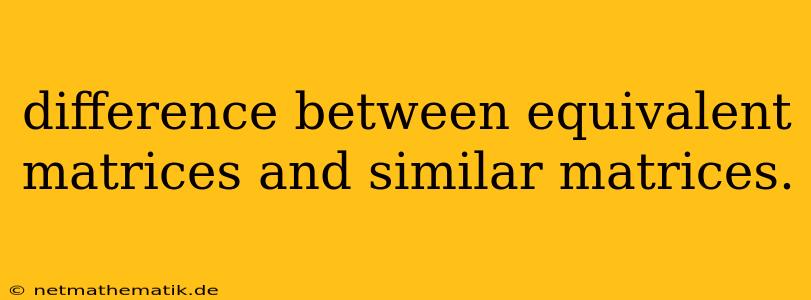In the realm of linear algebra, matrices play a crucial role in representing linear transformations and solving systems of equations. Two matrices can be related in various ways, and understanding these relationships is essential for comprehending their properties and applications. Among these relationships, two that are often confused are equivalent matrices and similar matrices. While both involve transformations of matrices, they differ significantly in their definitions and implications. This article aims to shed light on the difference between equivalent matrices and similar matrices, highlighting their defining characteristics and providing illustrative examples to solidify the distinction.
Equivalent Matrices
Equivalent matrices are matrices that can be obtained from each other through a sequence of elementary row operations. Elementary row operations are fundamental transformations that preserve the solution set of a system of linear equations represented by the matrix. These operations include:
- Swapping two rows: This operation interchanges the positions of two rows in the matrix.
- Multiplying a row by a nonzero scalar: This operation scales all the elements in a row by a non-zero constant.
- Adding a multiple of one row to another row: This operation adds a scalar multiple of one row to another row.
Key Properties of Equivalent Matrices:
- Solution Preservation: Equivalent matrices represent the same system of linear equations, implying that they have the same solution set.
- Rank Invariance: The rank of a matrix, which represents the number of linearly independent rows or columns, remains unchanged under elementary row operations. Therefore, equivalent matrices have the same rank.
- Determinant Relationship: The determinants of equivalent matrices are either equal or differ by a non-zero multiplicative factor.
Example:
Consider the following matrices:
A = [ 1 2 ; 3 4 ]
B = [ 1 0 ; 0 1 ]
Matrix B can be obtained from matrix A by performing the following elementary row operations:
- Subtract three times the first row from the second row.
- Subtract twice the second row from the first row.
Therefore, matrices A and B are equivalent.
Similar Matrices
Similar matrices, on the other hand, are matrices that represent the same linear transformation but with respect to different bases. In other words, they represent the same geometric transformation but with different coordinate systems.
Definition: Two square matrices A and B are similar if there exists an invertible matrix P such that:
B = P⁻¹AP
Key Properties of Similar Matrices:
- Same Eigenvalues: Similar matrices have the same eigenvalues. Eigenvalues represent the scaling factors of the linear transformation along specific directions.
- Same Determinant: Similar matrices have the same determinant, which reflects the scaling factor of the transformation in terms of volume or area.
- Same Trace: Similar matrices have the same trace, which is the sum of the diagonal elements and represents the sum of the eigenvalues.
Example:
Consider the following matrices:
A = [ 2 1 ; 0 2 ]
B = [ 3 1 ; -1 1 ]
Let:
P = [ 1 1 ; -1 1 ]
Then:
P⁻¹AP = [ 1 -1 ; 1 1 ] [ 2 1 ; 0 2 ] [ 1 1 ; -1 1 ] = [ 3 1 ; -1 1 ] = B
Therefore, matrices A and B are similar.
Distinguishing Between Equivalent and Similar Matrices
The key difference between equivalent matrices and similar matrices lies in the transformations they undergo. Equivalent matrices are related by elementary row operations, which preserve the solution set of a system of equations. Similar matrices, on the other hand, are related by a change of basis, which alters the coordinate system used to represent the transformation.
Equivalent matrices are not necessarily similar, and similar matrices are not necessarily equivalent. The concept of equivalence is a broader notion than similarity, meaning that all similar matrices are equivalent, but not vice versa.
Table summarizing the key differences:
| Property | Equivalent Matrices | Similar Matrices |
|---|---|---|
| Transformation | Elementary Row Operations | Change of Basis |
| Solution Preservation | Yes | No |
| Eigenvalues | Not necessarily equal | Equal |
| Determinant | Equal or differ by a factor | Equal |
| Trace | Not necessarily equal | Equal |
Conclusion
Understanding the difference between equivalent matrices and similar matrices is crucial for mastering linear algebra concepts and applying them to real-world problems. While both involve transformations of matrices, they differ significantly in their definitions and implications. Equivalent matrices preserve the solution set of a system of equations, while similar matrices represent the same transformation but with respect to different coordinate systems. By grasping these distinctions, one can effectively analyze matrices, solve systems of equations, and interpret linear transformations in various contexts.
